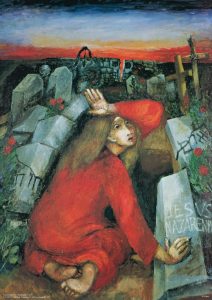HOMILY TUESDAY OF THE EASTER OCTAVE
Living Pentecost and Easter Faith
(Acts 2:36-41; Ps 32; Jn 20:11-18)
***********************************************
A motivational speaker, eager to share the message he brought with his audience, began his talk with the question, “Where to begin? Where to begin?” A participant suggested loudly from the back of the room, “Begin as near to the end as possible!”
That sense of too much good news to impart permeates the readings today. The interface between Pentecost and Easter; between the giving of the Holy Spirit and the Resurrection of Jesus, continues in the readings today from where they left off yesterday. This is the attitude of St. John, who in his eagerness to impart the fullness of the resurrection of Jesus has Pentecost happening on the same day as his rising from the dead.
The Octave of Easter, into which we are entering, is like celebrating Easter every day, so the readings will be somewhat repetitions. In the first reading, which mentions again “When the day of Pentecost had come,” St. Peter introduces some new elements into the picture. Now he proclaims without hesitation that God has made the crucified Jesus both Lord and Messiah.
As Messiah, Jesus had four roles to play: gather all nations to himself (this Jesus did throughout all his ministry); restore the glory of the Temple (this he did proclaiming that he is the new Temple); overcome the enemies of Israel (this he did by his resurrection, overcoming the real enemies of Israel and all humanity – sin, suffering and death), and rule over all creation (this he is now doing as Risen Lord, or Kyrios).
The response of the people should be our response as well: genuine repentance and letting go of our sinful ways, baptism into the Body of Christ so that we can receive God’s forgiveness, and openness to the indwelling of the Holy Spirit. This promise is for us as well as the early church, “for those who are near and far away.” And we are numbered among the followers of Jesus, the Church.

Appearance to Mary Magdalene by Fr. Sieger Köder
The Gospel repeats the Easter proclamation of the appearance of Jesus to Mary Magdalene. Two key elements leap out at us: Jesus calls Mary by name, and only then does she recognize him. This is the amazing particularity of God’s love not only for Mary, but also for each of us. Jesus calls us by name to follow him, knows us as his sheep, and wants an intimate personal prayer relationship with us.
The next element is the words of Jesus to Mary, “Do not hold on to me, for I have not yet ascended to my Father and your Father.” Essentially, Jesus was teaching her, and the apostles, to grieve and mourn his loss, for they could not have him back the way he was before. There was a transformation – he was now the Christ of faith and not just the Jesus of history. They would have to have faith for they would not see him any more, but if they would let him go and give him back to the Father, they would be able to receive his Spirit to be with them in a new way, as happened at Pentecost. And that was the birth of the Church. No wonder the liturgists felt compelled to roll Easter and Pentecost into one with these readings of the Octave of Easter.
The lesson for us is that it is important for us to mourn and grieve our losses as well, and not stay stuck in grief. Eventually, our faith invites us to let our deceased loved ones go and give them back to God, so that we can receive their spirit to be with us in a new way. We will then feel their presence, not miss them as much, and be able to move on in our lives, having done some good grieving.
When I arrived in Beauval a few years ago for the Holy Week celebrations, I was shocked to find out that Abraham Gardiner, whom I expected to see at the services, had passed away a few months earlier. I was not surprised, when I visited his widow Bernice on Holy Saturday (braving the snow, bad roads and potholes filled with dirty water) to find that she was doing so well. Certainly, she was saddened at her loss, but it was evident that she was also being carried by her faith in the resurrection of Jesus from the dead. She knew that death did not have the last word; that she would see her husband again, and even more, I believe was aware of his presence with her even now, in the Spirit, having given him back to God. That is Easter faith.
May our celebration empower us to respond to the Resurrection and the giving of the Spirit as did the early Church, and do our own good grieving, so that we can live life to the full with peace and joy.



